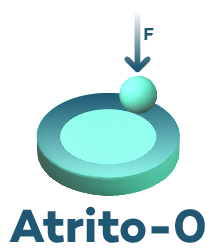ATRITO-0
A sinergia entre texturização e revestimentos auto-lubrificantes para contactos mecânicos energeticamente mais eficientes e mais amigos do ambiente
Desafio
O desafio principal deste projeto é a redução significativa do atrito em contatos mecânicos lubrificados através do efeito sinergético de revestimentos auto-lubrificantes adaptativos baseados em dicalcogenetos de metais de transição (TMD), depositados sobre superfícies texturadas. Com a abordagem proposta, pretende-se alcançar uma diminuição global do atrito em todos os regimes cinemáticos de lubrificação (seco, em camada limite, misto e hidrodinâmico), mesmo eliminando os aditivos utilizados nos lubrificantes, perniciosos para o meio ambiente.
Solução / Objetivo Principal
Para alcançar os objetivos de projeto, o programa de trabalhos prevê começar pela implementação industrial da deposição dos revestimentos à base de TMDs (WSC e MoSeC). A texturização de superfícies será efetuada num processo a dois passos por eletroerosão (EDM), usando elétrodos previamente texturizados recorrendo a técnicas de laser ou micromaquinagem. Após testes tribológicos lubrificados, será estudada a formação das tribocamadas de TMD nas superfícies de contato, assim como a influência das condições de ensaio nos coeficientes de atrito e desgaste. Este tipo de abordagem será replicado com as amostras texturizadas revestidas com TMD de modo a investigar o papel da topografia na lubrificação líquida / sólida.
Complementarmente a investigação será suportada por estudos teóricos de modelização e simulação para otimizar a distribuição e dimensão dos detalhes topográficos e compreender a formação da camada TMD por auto-adaptação. No que toca ao envolvimento dos parceiros, o IPN demonstrará a conveniência da utilização do processo de texturização em duas etapas (texturização de elétrodos + EDM) para a produção a grande escala de componentes texturizados, enquanto a Mahle aconselhará o consórcio na aplicação dos resultados e participará no teste em ambiente industrial de um protótipo modificado superficialmente de acordo com a solução otimizada alcançada.
Objetivos, Atividades e Resultados esperados / atingidos
Resultados atingidos:
1. Superfícies de aço texturizadas com geometrias predefinidas podem ser produzidas conforme pedido usando tecnologias de laser e EDM. Elétrodos de grafite foram produzidos usando texturização a laser e usados para texturizar superfícies de aço através EDM;
2. Revestimentos WSC com propriedades otimizadas foram depositados em amostras usando pulverização catódica;
3. As propriedades de revestimentos foram completamente caracterizadas relativamente às suas composições elementar e molecular, espessura, dureza, e módulo de Young. Amostras testadas foram investigadas usando microscopia ótica, perfilometria 3D, SEM/EDS, e espectroscopia Raman;
4. As superfícies texturizadas foram sujeitas a testes tribológicos, nomeadamente block-on-ring, cylinder-on-flat, e flat-on-flat;
5. As pistas de desgaste foram investigadas usando várias técnicas de caracterização. Vestígios de óxidos de ferro foram encontrados nas regiões texturizadas com desgaste;
6. Um modelo de método dos elementos finitos baseado na equação de Reynolds foi desenvolvido. Este modelo prevê o coeficiente de atrito e curvas de Stribeck para várias superfícies texturizadas e não texturizadas e para diferentes regimes de lubrificação.

Referência do projeto
POCI-01-0145-FEDER-030446Financiamento

Região de Intervenção
Norte (32,24%) e Centro (67,76%)Investimento Total
237.183,92Investimento do IPN
36.100,00Elegível Total
237.183,92Elegível do IPN
36.100,00Apoio Financeiro da UE - Total
FEDER - 201.606,33Apoio Financeiro da UE – IPN
FEDER - 30.685,00Apoio Financeiro Público Nacional – Total
OE - 35.577,59Apoio Financeiro Público Nacional – IPN
OE - 5.415,00Duração
48 MesesData de Início
2018-06-01Data de Fim
2022-05-31Data de Aprovação
2018-02-27Consórcio
Universidade de CoimbraUniversidade do Minho
Instituto Pedro Nunes
Mahle - Componentes de Motores, S.A.
Palavras-chave
Atrito ultrabaixo;Revestimentos PVD;
Texturização de superfícies;
Contato lubrificado;
Ultra low friction;
PVD coatings;
Surface texturing;
Lubricated contact.






